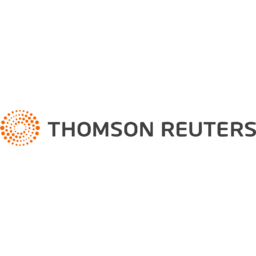
P/E ratio for Thomson Reuters (TRI)
P/E ratio as of April 2024 (TTM): 30.7
According to Thomson Reuters 's latest financial reports and stock price the company's current price-to-earnings ratio (TTM) is 30.6986. At the end of 2022 the company had a P/E ratio of 38.3.
P/E ratio history for Thomson Reuters from 2002 to 2023
PE ratio at the end of each year
| Year | P/E ratio | Change |
|---|---|---|
| 2022 | 38.3 | 280.04% |
| 2021 | 10.1 | -71.3% |
| 2020 | 35.1 | 59.1% |
| 2019 | 22.1 | 231.96% |
| 2018 | 6.64 | -66.05% |
| 2017 | 19.6 | 114.45% |
| 2016 | 9.12 | -55.94% |
| 2015 | 20.7 | 38.98% |
| 2014 | 14.9 | -92.8% |
| 2013 | 207 | 1868.43% |
| 2012 | 10.5 | -175.19% |
| 2011 | -14.0 | -146.71% |
| 2010 | 29.9 | 7.08% |
| 2009 | 27.9 | 84.03% |
| 2008 | 15.2 | 166.12% |
| 2007 | 5.71 | -72.62% |
| 2006 | 20.8 | -2.95% |
| 2005 | 21.5 | 6.39% |
| 2004 | 20.2 | -14.74% |
| 2003 | 23.7 | -8.92% |
| 2002 | 26.0 |
P/E ratio for similar companies or competitors
| Company | P/E ratio | P/E ratio differencediff. | Country |
|---|---|---|---|
 MSCI MSCI | 38.6 | 25.61% | 🇺🇸 USA |
 FactSet FDS | 34.5 | 12.45% | 🇺🇸 USA |
 Morningstar
MORN | 181 | 489.78% | 🇺🇸 USA |
 Shutterstock SSTK | 13.0 | -57.78% | 🇺🇸 USA |
 Pearson PSO | 22.1 | -27.86% | 🇬🇧 UK |
 Gannett GCI | -15.8 | -151.54% | 🇺🇸 USA |
 Dun & Bradstreet
DNB | -156 | -607.62% | 🇺🇸 USA |
How to read a P/E ratio?
The Price/Earnings ratio measures the relationship between a company's stock price and its earnings per share. A low but positive P/E ratio stands for a company that is generating high earnings compared to its current valuation and might be undervalued. A company with a high negative (near 0) P/E ratio stands for a company that is generating heavy losses compared to its current valuation.
Companies with a P/E ratio over 30 or a negative one are generaly seen as "growth stocks" meaning that investors typically expect the company to grow or to become profitable in the future.
Companies with a positive P/E ratio bellow 10 are generally seen as "value stocks" meaning that the company is already very profitable and unlikely to strong growth in the future.